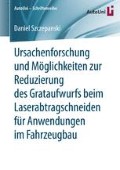Zusammenfassung
Im Vergleich zum Remote-Schweißen ist der Prozess des Abtragschneidens komplexer: Das schnelle Scannen bis hin zu 40 m/s führt zu einem Aufschmelz- und Verdampfungseffekt des Werkstoffes. Letzterer bewirkt zudem ein Herausschleudern von Teilen des verflüssigten Werkstoffes. Mit jeder neuen Überfahrt wird weiteres Material aus der Fuge abgetragen, bis das Werkstück letztendlich vollkommen getrennt ist.
Access this chapter
Tax calculation will be finalised at checkout
Purchases are for personal use only
Author information
Authors and Affiliations
Corresponding author
Rights and permissions
Copyright information
© 2017 Springer Fachmedien Wiesbaden GmbH
About this chapter
Cite this chapter
Szczepanski, D. (2017). Konkretisierung der Aufgabenstellung. In: Ursachenforschung und Möglichkeiten zur Reduzierung des Grataufwurfs beim Laserabtragschneiden für Anwendungen im Fahrzeugbau. AutoUni – Schriftenreihe, vol 106. Springer, Wiesbaden. https://doi.org/10.1007/978-3-658-19565-6_4
Download citation
DOI: https://doi.org/10.1007/978-3-658-19565-6_4
Published:
Publisher Name: Springer, Wiesbaden
Print ISBN: 978-3-658-19564-9
Online ISBN: 978-3-658-19565-6
eBook Packages: Computer Science and Engineering (German Language)

